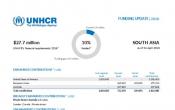Nepal
Operation: Nepal
Location
{"longitude":84,"latitude":28,"zoom_level":0,"iso_codes":"'NPL'"}
By clicking on the icons on the map, additional information is displayed.
Key Figures
| 2017 year-end results | |
| 100% | of refugees had access to primary health care |
| 100% | of known SGBV survivors received appropriate support |
| 100% | of Bhutanese refugee households had access to sustainable energy |
| 93% | of primary school aged refugee children were enrolled in primary education |
| 372 | Bhutanese refugees were provided with entrepreneurship training |
| 25 | litres of potable water, on average, was available per person per day |
| 6 | peaceful co-existence projects were implemented |
| 2018 planning figures | |
| 100% | of primary school-aged children enrolled in primary education (for Bhutanese and urban refugees) |
| 100% | of persons of concern have access to primary health care among Bhutanese and urban refugees |
| 100% | of households with access to sustainable energy for Bhutanese refugees |
| 550 | of urban and Bhutanese refugees provided with guidance on business market opportunities |
People of Concern
21%
Decrease in
2016
2016
| 2016 | 26,170 |
| 2015 | 33,068 |
| 2014 | 39,012 |

[["Refugees",25249],["Asylum-seekers",72],["Others of concern",849]]
Loading ...
Nepal
< Back
2017
{"categories":[2013,2014,2015,2016,2017,2018],"budget":[15.57919069,15.39627806,17.779095363,9.69132496,7.91013086,6.72710361],"expenditure":[8.69587504,7.64923815,10.25849726,6.59701288,6.95678777,null]}
{"categories":[2013,2014,2015,2016,2017,2018],"p1":[9.91735539,10.13508763,9.528128665,9.01183726,7.22951189,6.18810818],"p2":[1.40375575,2.23114183,1.794025568,0.6794877,0.68061897,0.53899543],"p3":[4.25807955,3.0300486,2.52347713,null,null,null],"p4":[null,null,3.933464,null,null,null]}
{"categories":[2013,2014,2015,2016,2017,2018],"p1":[6.85131978,6.78039167,5.72365518,6.19074725,6.3201619,null],"p2":[0.62798725,0.37696446,0.35181342,0.40626563,0.63662587,null],"p3":[1.21656801,0.49188202,0.49332446,null,null,null],"p4":[null,null,3.6897042,null,null,null]}
Loading ...
CHOOSE A YEAR
- 2015
- 2016
- 2017
- 2018
Operational context
While Nepal has not acceded to the 1951 Refugee Convention or its 1967 Protocol, and has no domestic asylum legislation, it has a long tradition of providing asylum to refugees and has generously hosted refugees for decades. The landmark parliamentary elections held in December 2017 led to the establishment of a new government and federal structures, as well as a process of localization which offers opportunities to strengthen strategic partnerships with development actors on the principle of leaving no one behind.Population trends
The overall number of people of concern to UNHCR decreased due to the resettlement departure of Bhutanese refugees. With the conclusion of the large-scale resettlement programme, over 112,000 refugees from Bhutan were resettled while the remaining camp-based population was approximately 7,400 by the end of 2017.UNHCR provided protection and assistance for approximately 690 urban refugees and asylum-seekers from nine countries.
Key achievements
The success of the Bhutanese resettlement programme opened avenues to pursue alternative solutions. UNHCR increasingly focused on enhancing self-reliance, strengthening a community-based approach, increasing refugees’ access to local services, and building synergies with local communities in the areas of education, health, livelihoods and social protection. Sectoral taskforces, consisting of local government offices, refugees, partners, civil society, and other stakeholders, were established in Damak, and strategic partnerships were expanded both in Kathmandu and Damak. Key achievements pertaining to livelihoods included the formation of self-help groups aimed at improving savings and loan practices; linking vocational skill development to market needs; and enhancing entrepreneurship skills.Unmet needs
The unmet needs of Bhutanese refugees were mostly linked with host community support projects in health, education, and livelihood activities. Due to limited resources, infrastructure support to local institutions aimed at building capacity to receive refugees was only partially implemented.Working environment
Nepal continues its recovery from the April-May 2015 earthquakes. In September 2015 the new Constitution of Nepal was promulgated thereby ensuring the completion of an essential element of the peace process. However, political tensions and uncertainties have led to a humanitarian and economic crisis in the country and negatively impacted on protection, assistance or resettlement activities.The large-scale departure of refugees through resettlement has resulted in a loss of economies of scale, raising the cost of delivery of basic services such as education, health care, water and sanitation, and household energy. Nevertheless, the Government of Nepal has remained a generous host to refugees for decades, with the international community complementing efforts in finding solutions mainly through resettlement to third countries.
Key priorities
UNHCR will continue to advocate for lasting solutions for the remaining refugees from Bhutan in Nepal following the conclusion of the group resettlement programme. Key activities include the implementation of small-scale host community support projects and the enhancement of protection and community services. These aim to benefit both refugees and host communities with a view to strengthening joint support mechanisms with linkages to district-level referral services.For urban refugees and asylum-seekers, UNHCR will provide assistance to cover basic needs. This includes a targeted subsistence allowance, primary health care services, and an education allowance for some 160 refugee children, while promoting durable solutions, including self-reliance and resettlement to third countries for extremely vulnerable individuals or people facing high protection risks.
UNHCR will continue to advocate for citizenship documentation for those without a citizenship certificate in line with international standards and to provide relevant technical advice. It will as well engage in strategic partnerships with UN agencies, embassies, domestic legal experts and other civil society actors for potential collaboration on citizenship issues.
